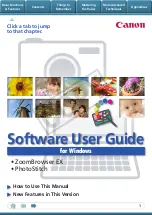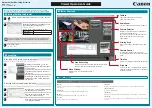
EPICenter Overview
EPICenter Reference Guide
22
●
Installed or web-based clients
. The EPICenter software gives you a choice of installing full-function
client software, or connecting to the EPICenter server through a web-browser-based client running
under Microsoft Internet Explorer or Mozilla Firefox.
●
Hierarchical displays
. Most information, including that found in EPICenter topology maps, VLAN
management, configuration management, and real-time statistics, is dynamically presented in an
easy-to-navigate hierarchical tree.
●
Multi-platform capability
. The EPICenter server supports Sun SPARC and Intel platforms, and the
Windows XP or 2003 Server, Linux and Solaris operating environments. Client applications on any
of these platforms can connect to servers on either platform.
●
Support for multiple users with security
. Users must log in to the EPICenter application, and can
be granted different levels of access to the application features based on their assigned role. Three
basic predefined roles are provided, and additional user roles can be created. Telnet and SSH access
to Extreme switches can also be controlled based on the user identity. To protect the sensitive data
from being intercepted or altered by unauthorized access, Secure Shell 2 (SSHv2) protocol and
HTTPS protocols are provided. These protocols encrypt traffic between the switch management port
and the EPICenter.
●
Installed or web-based clients
. The EPICenter software gives you a choice of installing full-function
client software, or connecting to the EPICenter server through a web-browser-based client running
under Microsoft Internet Explorer or Mozilla Firefox.
●
Monitor wireless Access Points (APs) and wireless clients.
Through EPICenter’s dynamic reports
you can monitor the status of the Altitude 300 APs connected to your network and monitor wireless
client activity connected through those APs. You can also detect rogue APs connected to the
network, and add them to a “safe” list, or disable access to them if necessary.
●
Support for third-party devices
. Any device running a MIB-2 compatible SNMP agent can be
discovered by the EPICenter Inventory Manager and monitored at a basic level. These devices can
appear on a topology map, with basic status and alarm handling based on MIB-2 functionality.
Based on EPICenter’s Third Party Integration Framework, selected appliances from Extreme
Networks partners can be integrated into EPICenter in a robust fashion that allows reporting, the use
of Telnet macros, alarm management, and monitoring with graphical front and back panel views in
the Inventory Manager.
●
Manage large numbers of devices.
The EPICenter Gold Upgrade enables the EPICenter server to
manage up to 2000 devices with a single installation of the EPICenter software. For even larger
networks, you can split the management task among several EPICenter servers in a distributed
server mode that lets you monitor the status of those servers from a single client.
●
Policy-based management.
The EPICenter Advanced Upgrade is an optional, separately licensed
component of the EPICentersoftware that lets you work with high-level policy components (users,
desktop systems, groups of users, devices, or applications) in defining network policies used to
protect and guarantee delivery of mission-critical traffic. The policy system translates these into the
specific information needed for QoS configuration of network devices. It also detects overlaps and
conflicts in policies, with precedence rules for resolving conflicting QoS rules.
Extreme Networks switches and many other MIB-2 compatible devices can be monitored and controlled
from a central interface, without exiting EPICenter to run a separate program or Telnet session. Features
such as SmartTraps
and the EPICenter alarm system further maximize network monitoring capability
while maintaining network usage efficiency.
You can organize your network resources into
non-exclusive
groups (including groups made up of
selected ports from multiple switches) that you can manage as a single entity. Device groupings can be
based on a variety of factors, such as physical location, logical grouping, devices that support SSH2, and
so on. Using device groups, you can search for individual IP addresses and identify their connections
into the network. You can monitor the status of your network devices either visually, through the
Summary of Contents for EPICenter 6.0
Page 14: ...EPICenter Reference Guide 14 ...
Page 18: ...Preface EPICenter Reference Guide 18 ...
Page 19: ...1 EPICenter Basic Features ...
Page 20: ......
Page 24: ...EPICenter Overview EPICenter Reference Guide 24 ...
Page 44: ...Getting Started with EPICenter EPICenter Reference Guide 44 ...
Page 100: ...The Inventory Manager EPICenter Reference Guide 100 ...
Page 140: ...The EPICenter Alarm System EPICenter Reference Guide 140 ...
Page 172: ...Configuration Manager EPICenter Reference Guide 172 ...
Page 196: ...The Firmware Manager EPICenter Reference Guide 196 ...
Page 220: ...The Interactive Telnet Feature EPICenter Reference Guide 220 ...
Page 250: ...The Grouping Manager EPICenter Reference Guide 250 ...
Page 276: ...Real Time Statistics EPICenter Reference Guide 276 ...
Page 342: ...Using the VLAN Manager EPICenter Reference Guide 342 ...
Page 348: ...The ESRP Monitor EPICenter Reference Guide 348 ...
Page 446: ...EPICenter Reports EPICenter Reference Guide 446 ...
Page 447: ...2 Advanced Upgrade Features ...
Page 448: ......
Page 480: ...EAPS Protocol Monitoring and Verification EPICenter Reference Guide 480 ...
Page 508: ...Using the Policy Manager EPICenter Reference Guide 508 ...
Page 525: ...3 Appendices ...
Page 526: ......
Page 542: ...EPICenter Backup EPICenter Reference Guide 542 ...
Page 564: ...Voice over IP Manager EPICenter Reference Guide 564 ...
Page 580: ...EPICenter Reference Guide 580 ...
















































